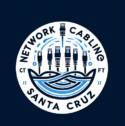Is Fiber Optic a Cable? Understanding How Fiber Works and Why It Matters
If you’ve ever wondered, “Is fiber optic a cable?”, the simple answer is yes — but it’s very different from traditional copper cabling. Instead of carrying electrical signals, fiber optic cables use pulses of light to transmit data at incredible speeds over long distances.
In today’s connected world, fiber optic cabling powers everything from high-speed internet and data centers to security systems and smart buildings. Whether for home or business, understanding how fiber optics work can help you choose the right infrastructure for your network. Our team of structured cabling professionals in Santa Cruz specializes in modern fiber optic and network cable installations for homes and businesses.
What Is a Fiber Optic Cable?
A fiber optic cable is made up of thin strands of glass or plastic fibers that carry information as light signals. Each strand is thinner than a human hair, yet it can transmit massive amounts of data in just milliseconds.
Here’s how it works:
- Core – The central part of the fiber where light travels.
- Cladding – A layer that reflects light back into the core to keep it moving.
- Buffer coating – A protective outer layer that prevents damage and interference.
Together, these layers allow data to travel at nearly the speed of light — making fiber optics one of the most efficient transmission mediums available.
How Fiber Optic Cables Differ from Copper Cables
Traditional Ethernet cables like CAT6 use electrical signals to transfer data. While effective for short distances, electrical interference, resistance, and signal loss can limit performance.
Fiber optic cables, on the other hand, use light instead of electricity, offering several key advantages:
- Faster speeds – Supports bandwidths up to 100 Gbps and beyond.
- Longer distance – Data can travel miles without signal degradation.
- No interference – Immune to electromagnetic and radio frequency noise.
- Higher security – Harder to tap or intercept data.
- Future-ready – Built to handle growing demands for streaming, cloud computing, and smart devices.
Because of these benefits, many California businesses and tech-savvy homeowners are switching from copper to fiber to support advanced systems and faster networks.
Types of Fiber Optic Cables
There are two main types of fiber optic cables, each designed for specific applications:
- Single-Mode Fiber (SMF)
- Uses a single light path
- Best for long-distance transmission (up to 40 km or more)
- Common in telecommunications and large enterprise networks
- Multi-Mode Fiber (MMF)
- Uses multiple light paths
- Ideal for shorter distances (up to 550 meters)
- Common in data centers, schools, and commercial buildings
Choosing between the two depends on how far your signal needs to travel and how much bandwidth you require.
Applications of Fiber Optic Cables
Fiber optic cabling is used across a wide range of industries in California and beyond, including:
- Internet service providers (ISPs) – Delivering high-speed broadband connections
- Corporate offices – Supporting large-scale data networks and VoIP systems
- Security and surveillance – Connecting IP cameras with zero signal loss
- Healthcare – Transmitting medical data securely and instantly
- Smart homes – Powering fast Wi-Fi and home automation systems
As technology continues to evolve, fiber optics are becoming the standard for both residential and commercial network installations.
Why Fiber Optic Cabling Is the Future
As more devices and systems rely on fast data transfer, fiber optics are quickly replacing older cabling technologies. In California, many businesses are upgrading to fiber network installations to stay competitive and meet future bandwidth needs.
Key reasons fiber optics are the future of connectivity:
- They support cloud-based operations and video conferencing without lag.
- They can handle the growth of smart cities and connected infrastructure.
- They reduce downtime and improve the reliability of communication systems.
In short, fiber optic cables aren’t just a trend — they’re the backbone of the digital future.
Choosing Professional Fiber Installation Services
Installing fiber optic cabling requires precision, experience, and specialized tools. Working with certified installers ensures proper splicing, routing, and testing of each fiber strand. Professionals also ensure compliance with California building codes and industry standards such as TIA/EIA and BICSI.
Professional fiber installers provide:
- Accurate testing and certification of all fiber connections
- Compliance with state and safety regulations
- Clean, organized cable management for long-term reliability
- Future-proof network design for expansion and upgrades
If you’re planning to modernize your network infrastructure, choosing expert fiber optic installation services will ensure you get the speed, reliability, and performance your system needs.
Final Thoughts
So, is fiber optic a cable? Absolutely — and it’s one of the most advanced and reliable types available today. Unlike traditional copper cabling, fiber uses light to deliver lightning-fast data transfer over long distances with minimal interference. If you’re comparing fiber optics with other options, you might wonder what the fastest network cable is for high-speed data transmission.
Whether you’re upgrading your business network or setting up high-speed internet for your home, fiber optic cabling is the best choice for a fast, secure, and future-ready connection.
Contact your trusted fiber optic installation experts in California today to learn more about upgrading your system and experiencing the difference that true high-speed connectivity can make.
